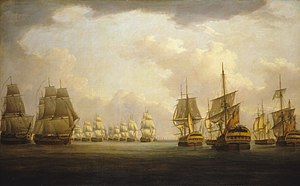Battle of Cape Finisterre (1805)
| Battle of Cape Finisterre | |||||||
|---|---|---|---|---|---|---|---|
| Part of the Napoleonic Wars | |||||||
 Admiral Sir Robert Calder's action off Cape Finisterre, 23 July 1805, by William Anderson. The captured Spanish prizes Firme and San Raphael, are under tow on the right and the damaged HMS Windsor Castle, on the left. |
|||||||
|
|||||||
| Belligerents | |||||||
|
|
|
||||||
| Commanders and leaders | |||||||
|
|
|
||||||
| Strength | |||||||
| 15 ships of the line | 20 ships of the line | ||||||
| Casualties and losses | |||||||
| 198 dead or wounded | 647 dead or wounded, 2 ships captured, 1,200 prisoners |
||||||
In the Battle of Cape Finisterre (22 July 1805) off Galicia, Spain, the British fleet under Admiral Robert Calder fought an indecisive naval battle against the combined Franco-Spanish fleet which was returning from the West Indies. Failing to prevent the joining of French Admiral Pierre de Villeneuve's fleet to the squadron of Ferrol and to strike the shattering blow that would have freed Great Britain from the danger of an invasion, Calder was later court-martialled and severely reprimanded for his failure and for avoiding the renewal of the engagement on 23 and 24 July. At the same time, in the aftermath Villeneuve elected not to continue on to Brest, where his fleet could have joined with other French ships to clear the English Channel for an invasion of Great Britain.
The fragile Peace of Amiens of 1802 had come to an end when Napoleon formally annexed the Italian state of Piedmont and on 18 May 1803 Britain was once again at war with France.
Napoleon planned to end the British blockade by invading and conquering Britain. By 1805 his Armée d'Angleterre was 150,000 strong and encamped at Boulogne. If this army could cross the English Channel, victory over the poorly trained and equipped militias was very likely. The plan was that the French navy would escape from the British blockades of Toulon and Brest and threaten to attack the West Indies, thus drawing off the British defence of the Western Approaches. The combined fleets would rendezvous at Martinique and then double back to Europe, land troops in Ireland to raise a rebellion, defeat the weakened British patrols in the Channel, and help transport the Armée d'Angleterre across the Straits of Dover.
...
Wikipedia
